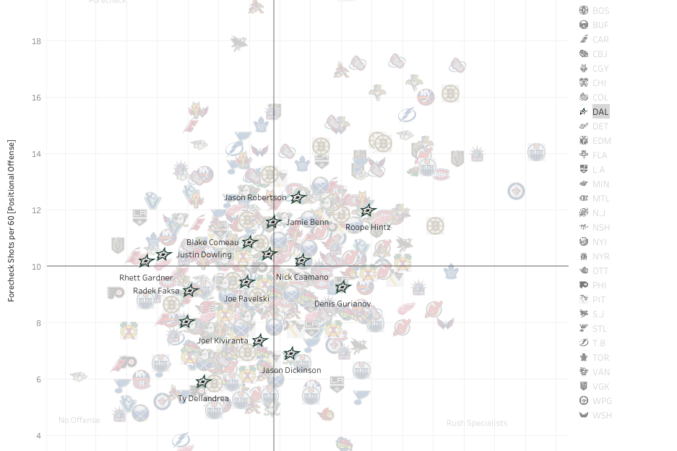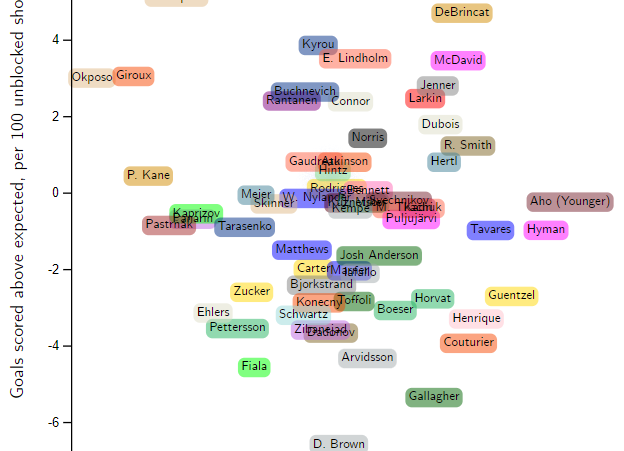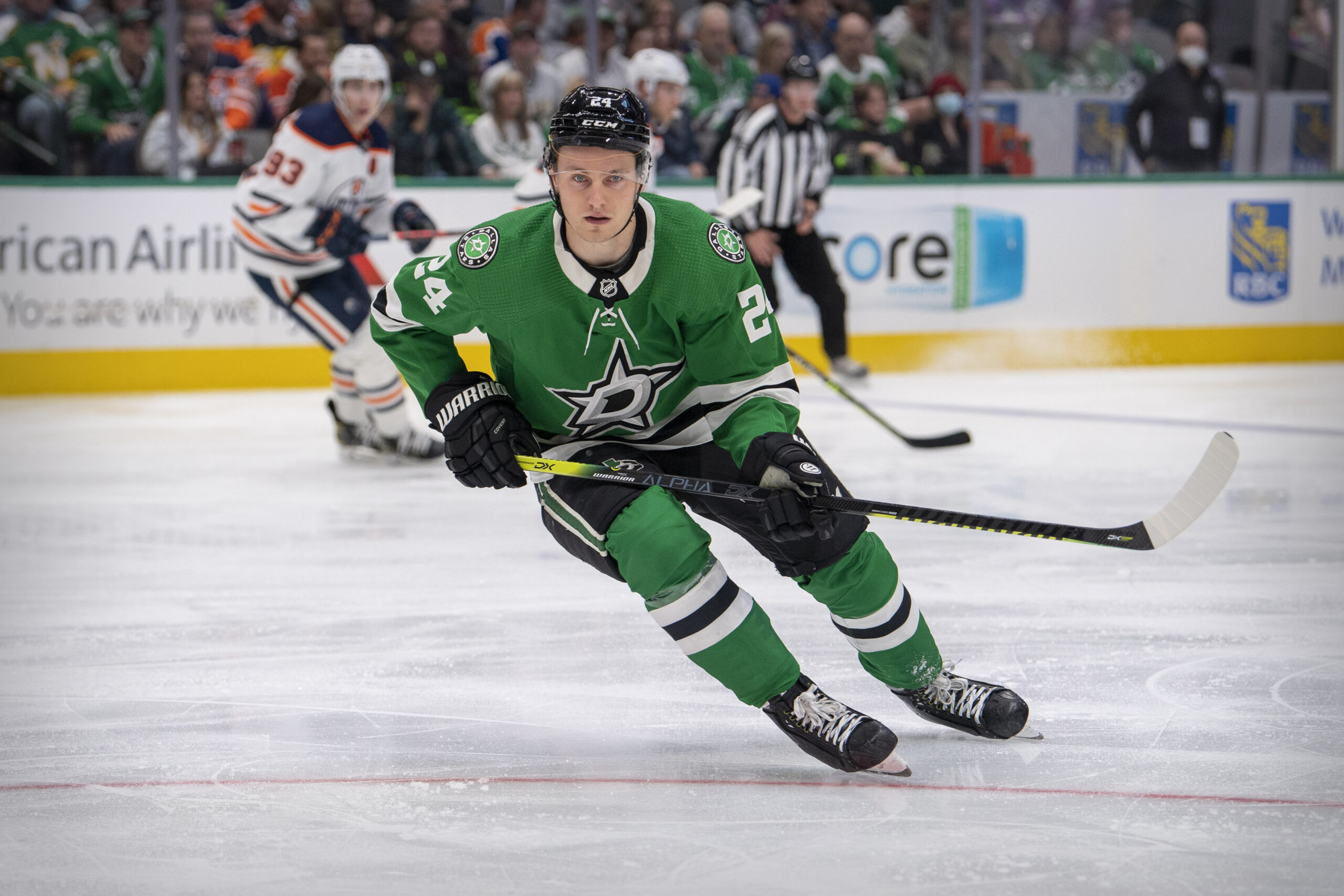The game’s most elite players typically start out as the game’s most elite teenagers. For Connor McDavid, Auston Matthews, and Leon Draisaitl, development is a sprint. They’re up and running from the word “go.” For everybody else, development is a marathon. Believe it or not, there’s a relationship between the speed with which a player develops and the frequency with which he can contribute. In 2017, Namita Nadakumar (currently a quantitative analyst for the Seattle Kraken) revealed that a typical prospect takes four seasons to make the NHL. However, a typical prospect who can contribute in his initial post-draft year will be twice as impactful as a player who makes it after five years. Roope Hintz should be a typical prospect; he’s anything but.
In fact, Hintz defies a lot of stereotypes and expectations about player development in general. His first-year AHL campaign was decent but unspectacular, tallying 35 points in 70 games. His first-year NHL campaign was decent but unspectacular, too, tallying 22 points in 55 games. His sophomore year showed decent but unspectacular growth. And then, despite not playing with an entire pelvis, he went supernova—not only scoring at an 83-point pace over a full season but practically doubling his internal analytics, which almost never happens.
Whatever clicked inside his head, or whatever sword he pulled out of a stone, it is now working yet again. After an early drought to open the 2021-2022 season, Hintz is back.
Granted, Hintz has a lot of help, but the same can be said about every other forward. Nathan MacKinnon has Mikko Rantanen, Matthews has Mitch Marner, etc. Hintz, meanwhile, has Jason Robertson and Joe Pavelski. They’re the perfect trio in a lot of ways. If you think of offense the way you do a movie version of pulling off the “big score,” then they’re the ideal heist crew, right on down to the clichés of geeky tech guy (Pavelski), wheelman (Hintz), and the muscle (Robertson). However, I’d argue that Hintz stands above his linemates in a way that analogy does and doesn’t do justice to.
For one, the center position comes with unique challenges, and Hintz handles them shockingly well despite profiling like more of a winger his draft year. There’s a reason centers get paid the most, just like there’s a reason you have to go back to Jere Lehtinen’s prime to find a Selke award winner who wasn’t a center: the position demands more than what the average forward is equipped to deliver. The line of Robertson-Hintz-Pavelski is one of the top five forward trios in the league right now, and Hintz is a big reason why. Is he the biggest reason why? That’s what I believe the data say. The trio’s threat level is defined by the different ways it can attack, and no player better embodies the dual threat of attacking in transition and on the rush while also attacking from position and on the forecheck.

Hintz led the team last season in shots from the rush and nearly led the team in shots off the forecheck. The same patterns are true this season, with Hintz once again acting as Dallas’ primary shot assist leader, facilitating the puck across all three zones with elite speed and accuracy. While Robertson and Pavelski have outproduced Hintz up to this point, they haven’t outperformed him. According to Dom Luszczyszyn’s model, Hintz is worth 2.7 wins, the best of any Dallas forward, which means Dallas’ current pace of 90 points with Hintz would be almost 84 without him. Some models have his worth closer to four wins than three.
The distinction between production and performance matters because it potentially answers the question: what if Hintz is one of the NHL’s best forwards, period?
It’s not crazy. According to Natural Stat Trick, among all forwards this year with at least 100 minutes of ice time, Hintz ranks ninth in shot quality generated on his own (ixG/60), second in individual scoring chances created (iSCF), and fifth in high danger shot attempts (iHDCF).
Hintz isn’t just the team leader when it comes to facilitating offense for others and himself; he’s one of the league leaders.
Below is a collection of the league’s best when it comes to goals we can expect them to score given the shot quality they generate (x axis), and the frequency with which they meet those expectations (y axis). You’ll need to squint your eyes for the pale green overlay, but Hintz is smack dab in the middle, just below Johnny Gaudreau and just above William Nylander.

Hintz is currently on pace for 30 goals this season, and according to Micah Blake McCurdy’s model, he’s generating the kind of quality that should net him closer to 38. Shooting percentages will define how far and in what direction the pendulum swings, but flirting with 40 goals would be an amazing accomplishment considering only 34 players broke the 40-goal barrier between 2013 and 2019. Normally you’d want to bet the under on that, but Hintz is currently sixth on the team in even-strength scoring (not good) and has just one goal on the power play (even worse). And yet, last season, only one other player was on pace to score more than nine points per 60 minutes of play on the man advantage: Connor McDavid.
Speaking of McDavid, “relative to teammates” is a pretty basic stat that does exactly what you’d think: measure how players perform compared to others on their roster. What’s the plus/minus of a player when he’s on the ice versus the plus/minus of a team when that player is on the bench? Dallas generates 8.11 additional scoring chances per 60 minutes of even-strength play with Hintz on the ice. There are only six players in the league since last season who add as many or more scoring chances to their team when they’re on the ice versus what their team generates when they’re not, and three of them are McDavid and his linemates.
If there’s anything standing in Hintz’s way, it’s his deployment. Since last season, Hintz has averaged 12:52 minutes per game at even strength, which is functionally second-line center minutes (next to names like Steven Stamkos and Nazem Kadri). If we include all situations, his ice time jumps to 17:38 per game, which isn’t as much as it sounds. Last season, his lingering injury limited his play. This season? Perhaps his style doesn’t lend itself to heavy usage. Perhaps his quick burst rushes can only be maximized if his minutes are managed. Maybe. However, that doesn’t seem to be a problem for other quick burst players like McDavid (22:12), Dylan Larkin (19:45), or Zach Hyman (19:11). There are far younger players whose minutes aren’t carefully curated (Jack Hughes at 18:54) and older players who don’t need a walker for their workload (Patrick Kane and Alex Ovechkin both play more than 20 minutes per night). Is this a big deal? I think so, but that’s not what this is about.
It’s easy to get lost in the big picture of things. Teams talk about “winning now” like it can be bought and paid for. But that’s not how it works. Winning is a lot like development. All the right ingredients have to come together so that a formula is eventually created and the structure set. “Winning now” doesn’t happen without a plan before and a vision for after. Just ask the Montreal Canadiens what it’s worth to “win now” at the cost of everything else. How many fans of the 2015-2016 San Jose Sharks, the 2016-2017 Nashville Predators, or the 2019-2020 Vancouver Canucks would gladly trade in their Cinderella runs for a clearer future? It all starts with the right ingredients, and Hintz looks like he’s part of a strong formula for success: one of the game’s fastest centers who makes an impact all over the ice for others, for himself, and at even strength or special teams (both sides, no less). He’s got the legs. When will Dallas finally hand him the baton?






